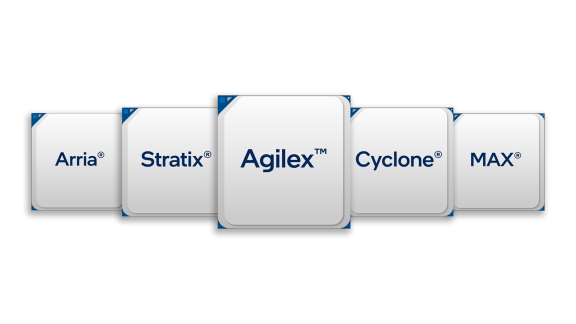Altera® FPGAs and Programmable Solutions
Get the flexibility you need and accelerate your innovation with a broad portfolio of programmable logic products including FPGAs, CPLDs, Structured ASICs, acceleration platforms, software, and IP.
Download FPGA Product Catalog
Featured Stories
How to Deliver Rock-Solid Supply in a Complex and Ever-Changing World
Learn how a combination of careful planning, focused investment, accurate tracking, and commitment to product longevity delivers the resilient supply chain FPGA customers require.
Power and Performance Analysis of Finite Impulse Response Filters (FIR) and Fast Fourier Transforms (FFT) on Agilex™ 7 FPGAs
This paper analyzes the power and performance efficiency of several FIR and FFT configurations on Agilex™ 7 FPGAs and AMD’s Versal FPGAs.
Key Applications of the Agilex™ 5 FPGA E-Series
Explore key applications the Agilex™ 5 FPGA E-Series is built for and how the key features and capabilities of this product are addressing challenges for next generation designs.
Next-Generation 4K Camera Designs with Agilex™ 5 FPGAs
Learn how to leverage and benefit from Agilex™ 5 FPGAs and the extensive collection of IPs to develop full-featured vision camera solutions.
Integrated ADC/DAC
Intel FPGAs with integrated high-performance data converters help customers obtain wide instantaneous bandwidth and direct RF capabilities while increasing performance, decreasing power, and reducing product size.
Digital Signal Processing
Intel FPGAs feature variable-precision DSP blocks with support for floating-point operations, enabling high performance and high-efficiency implementation of a wide range of signal processing functions.
External Memory Interfaces
Address your memory bandwidth needs with high-performance and high-efficiency interfaces to external memories such as DDR4, DDR5, and more.
Chiplet-Based Heterogenous Integration
Intel’s chiplet-based approach to heterogenous integration increases the rate of FPGA innovation and enables new degrees of product customization.
Transceivers
Intel helps address your next-generation bandwidth requirements with industry-leading transceiver I/O technology.
Security
The latest Intel FPGAs feature the Secure Device Manager as the foundation of our suite of security capabilities including secure boot, anti-tamper, attestation and cryptographic acceleration.
Resources

Support Resources
Find FPGA support resources, self-help information, step-by-step guidance, knowledge-base articles, and more.

Documentation
Access FPGA documentation index collection to find user guides, datasheets, release notes, and more.

Training
Deepen and sharpen your FPGA design skills with Intel FPGA technical training.

New to FPGA
Learn what an FPGA is and explore resources to get started with your own design.
